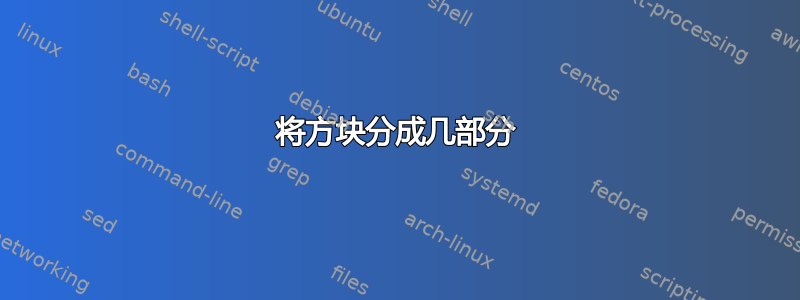
我基本上想分解该图右侧的 ADC 块:
我希望将其分成 4 个部分。这意味着它所连接的每条线路都有一个部分。每个 ADC 块都有一个 I/O。
代码如下:
\documentclass[tikz,border=2mm]{standalone}
\usepackage{circuitikz}
\usetikzlibrary{chains,fit,positioning}
\begin{document}
% Version 3
\begin{tikzpicture}[
node distance = 20mm and 5mm,
start chain = going right,
block/.style = {draw, minimum height=20mm, minimum width=5mm,
font=\boldmath,on chain}]
% upper blocks
\node (ht1) [block,draw=none]
{\hphantom{$\boldmath(H)^+$}};
\node (f1) [block,right=6mm of ht1] {$T^{-1}$};
\node (y1) [block,right=39mm of ht1] {$T$};
\node (adc1) [block] {ADC};
% lower blocks
\node (ht2) [block,draw=none,below=of ht1]
{\hphantom{$\boldmath(H)^+$}};
\node (f2) [block,right=6mm of ht2] {$T^{-1}$};
\node (y2) [block,right=39mm of ht2] {$T$};
\node (adc2) [block] {ADC};
% common input nodes
\node (in2) [draw,inner sep=0pt, fit=(ht1) (ht2),label=center:$\boldmath H^+$] {};
% top blocks
\node (cpu) [above=15mm of in2] {CPU};
\node (rf) [above=15mm of y1] {RF-chain};
% Math symbols
%\node at (42mm,15mm) (g1) {$\boldmath Y_1$};
\node (Y) at (53mm,18mm) {$\boldmath Y_1$};
\draw [->] (Y) -- (53mm,10mm);
\node (Y2) at (53mm,-23mm) {$\boldmath Y_k$
};
\draw [->] (Y2) -- (53mm,-30mm);
\node (Z) at (41mm,6mm) {$\boldmath Z_1$};
\node (Z2) at (41mm,-34mm) {$\boldmath Z_k$};
\node (x) at (-12mm,11mm) {$\boldmath \hat{x}$};
\draw[densely dotted] ([xshift=29mm] cpu.north -| in2.east) coordinate (in3)
-- (in3 |- in2.south);
% lines between blocks
\foreach \y in {-0.75, -0.25, 0.25, 0.75}
{
% 8 input lines
\draw [->] ([yshift=\y cm +2 cm] in2.west)--++(180:1cm);
\draw [->] ([yshift=\y cm -2 cm] in2.west)--++(180:1cm);
}
% 2 lines between other blocks
\foreach \j in {1, 2}
{
\foreach \y in {-0.25, 0.25, 0.75, -0.75}
{
\foreach \i [remember=\i as \lasti (initially y\j)] in {adc\j}
\draw [<-] ([yshift= \y cm ]\lasti.east)--([yshift=\y cm]\i.west);
\draw (-1,-2.0) circle [radius=0.7pt,yshift=-0 cm -\y cm];
\draw (3.95,-2.0) circle [radius=0.7pt,yshift=-0 cm -\y cm];
%\draw (0,-1) -- (4,-1);
%\draw ([yshift= 0.5 cm -\y cm] adc\j.east)--++(0:1+1.5*\y) node[antenna] {};
\draw ([yshift=-0 cm -\y cm] adc\j.east)--++([xshift=1.5cm] 0:1+1.5*\y) node[antenna] {};
}
\foreach \y in {-0.25, 0.25}
{
\foreach \i [remember=\i as \lasti (initially f\j)] in { y\j}
\draw [<-] ([yshift= \y cm ]\lasti.east)--([yshift=\y cm]\i.west);
}
\foreach \y in {-0.25, 0.25, 0.75, -0.75}
{
\foreach \i [remember=\i as \lasti (initially ht\j)] in { f\j}
\draw [<-] ([yshift= \y cm ]\lasti.east)--([yshift=\y cm]\i.west);
}
}
\end{tikzpicture}
\end{document}
也许可以直接在以下行中进行操作:
\node (adc1) [block] {ADC};
答案1
一个建议。我首先定义一种新样式block4,即rectangle split类型节点,即具有多个部分的矩形节点。shapes.multipart库因此加载。在adc节点中,将样式从 更改为block,block4并将节点标签更改为ADC\nodepart{two}ADC\nodepart{three}ADC\nodepart{four}ADC。
\documentclass[tikz,border=2mm]{standalone}
\usepackage{circuitikz}
\usetikzlibrary{chains,fit,positioning,shapes.multipart}
\begin{document}
% Version 3t
\begin{tikzpicture}[
node distance = 20mm and 5mm,
start chain = going right,
block/.style = {draw, minimum height=20mm, minimum width=5mm,
font=\boldmath,on chain},
block4/.style={block,rectangle split,rectangle split parts=4}]
% upper blocks
\node (ht1) [block,draw=none]
{\hphantom{$\boldmath(H)^+$}};
\node (f1) [block,right=6mm of ht1] {$T^{-1}$};
\node (y1) [block,right=39mm of ht1] {$T$};
\node (adc1) [block4] {ADC\nodepart{two}ADC\nodepart{three}ADC\nodepart{four}ADC};
% lower blocks
\node (ht2) [block,draw=none,below=of ht1]
{\hphantom{$\boldmath(H)^+$}};
\node (f2) [block,right=6mm of ht2] {$T^{-1}$};
\node (y2) [block,right=39mm of ht2] {$T$};
\node (adc2) [block4] {ADC\nodepart{two}ADC\nodepart{three}ADC\nodepart{four}ADC};
% common input nodes
\node (in2) [draw,inner sep=0pt, fit=(ht1) (ht2),label=center:$\boldmath H^+$] {};
% top blocks
\node (cpu) [above=15mm of in2] {CPU};
\node (rf) [above=15mm of y1] {RF-chain};
% Math symbols
%\node at (42mm,15mm) (g1) {$\boldmath Y_1$};
\node (Y) at (53mm,18mm) {$\boldmath Y_1$};
\draw [->] (Y) -- (53mm,10mm);
\node (Y2) at (53mm,-23mm) {$\boldmath Y_k$
};
\draw [->] (Y2) -- (53mm,-30mm);
\node (Z) at (41mm,6mm) {$\boldmath Z_1$};
\node (Z2) at (41mm,-34mm) {$\boldmath Z_k$};
\node (x) at (-12mm,11mm) {$\boldmath \hat{x}$};
\draw[densely dotted] ([xshift=29mm] cpu.north -| in2.east) coordinate (in3)
-- (in3 |- in2.south);
% lines between blocks
\foreach \y in {-0.75, -0.25, 0.25, 0.75}
{
% 8 input lines
\draw [->] ([yshift=\y cm +2 cm] in2.west)--++(180:1cm);
\draw [->] ([yshift=\y cm -2 cm] in2.west)--++(180:1cm);
}
% 2 lines between other blocks
\foreach \j in {1,2}
{
\foreach \y/\anchor in {-0.25/two east, 0.25/three east, 0.75/four east, -0.75/text east}
{
\foreach \i [remember=\i as \lasti (initially y\j)] in {adc\j}
\draw [<-] ([yshift= \y cm ]\lasti.east)--([yshift=\y cm]\i.west);
\draw (-1,-2.0) circle [radius=0.7pt,yshift=-0 cm -\y cm];
\draw (3.95,-2.0) circle [radius=0.7pt,yshift=-0 cm -\y cm];
%\draw (0,-1) -- (4,-1);
%\draw ([yshift= 0.5 cm -\y cm] adc\j.east)--++(0:1+1.5*\y) node[antenna] {};
\draw ([yshift=-0 cm -\y cm] adc\j.east)--++([xshift=1.5cm] 0:1+1.5*\y) node[antenna] {};
}
\foreach \y in {-0.25, 0.25}
{
\foreach \i [remember=\i as \lasti (initially f\j)] in { y\j}
\draw [<-] ([yshift= \y cm ]\lasti.east)--([yshift=\y cm]\i.west);
}
\foreach \y in {-0.25, 0.25, 0.75, -0.75}
{
\foreach \i [remember=\i as \lasti (initially ht\j)] in { f\j}
\draw [<-] ([yshift= \y cm ]\lasti.east)--([yshift=\y cm]\i.west);
}
}
\end{tikzpicture}
\end{document}
答案2
另一种解决方案。它保留phantomadc1 和 adc2 节点,因为它们稍后用于绘制连接。但是绘制连接时会添加一个单独的节点。
我也改变了内在foreach状态。
\documentclass[tikz,border=2mm]{standalone}
\usepackage{circuitikz}
\usetikzlibrary{chains,fit,positioning}
\begin{document}
% Version 3
\begin{tikzpicture}[
node distance = 20mm and 5mm,
start chain = going right,
block/.style = {draw, minimum height=20mm, minimum width=5mm,
font=\boldmath,on chain}]
% upper blocks
\node (ht1) [block,draw=none]
{\hphantom{$\boldmath(H)^+$}};
\node (f1) [block,right=6mm of ht1] {$T^{-1}$};
\node (y1) [block,right=39mm of ht1] {$T$};
\node (adc1) [block, draw=none] {\phantom{ADC}};
% lower blocks
\node (ht2) [block,draw=none,below=of ht1]
{\hphantom{$\boldmath(H)^+$}};
\node (f2) [block,right=6mm of ht2] {$T^{-1}$};
\node (y2) [block,right=39mm of ht2] {$T$};
\node (adc2) [block, draw=none] {\phantom{ADC}};
% common input nodes
\node (in2) [draw,inner sep=0pt, fit=(ht1) (ht2),label=center:$\boldmath H^+$] {};
% top blocks
\node (cpu) [above=15mm of in2] {CPU};
\node (rf) [above=15mm of y1] {RF-chain};
% Math symbols
%\node at (42mm,15mm) (g1) {$\boldmath Y_1$};
\node (Y) at (53mm,18mm) {$\boldmath Y_1$};
\draw [->] (Y) -- (53mm,10mm);
\node (Y2) at (53mm,-23mm) {$\boldmath Y_k$
};
\draw [->] (Y2) -- (53mm,-30mm);
\node (Z) at (41mm,6mm) {$\boldmath Z_1$};
\node (Z2) at (41mm,-34mm) {$\boldmath Z_k$};
\node (x) at (-12mm,11mm) {$\boldmath \hat{x}$};
\draw[densely dotted] ([xshift=29mm] cpu.north -| in2.east) coordinate (in3)
-- (in3 |- in2.south);
% lines between blocks
\foreach \y in {-0.75, -0.25, 0.25, 0.75}
{
% 8 input lines
\draw [->] ([yshift=\y cm +2 cm] in2.west)--++(180:1cm);
\draw [->] ([yshift=\y cm -2 cm] in2.west)--++(180:1cm);
}
% 2 lines between other blocks
\foreach \j in {1, 2}
{
\foreach \y in {-0.25, 0.25, 0.75, -0.75}
{
\foreach \i in {adc\j}
\draw [<-] ([yshift= \y cm ]y\j.east)--([yshift=\y cm]\i.west) node[draw, minimum height=3.5mm, anchor=west]{ADC};
\draw (-1,-2.0) circle [radius=0.7pt,yshift=-0 cm -\y cm];
\draw (3.95,-2.0) circle [radius=0.7pt,yshift=-0 cm -\y cm];
%\draw (0,-1) -- (4,-1);
%\draw ([yshift= 0.5 cm -\y cm] adc\j.east)--++(0:1+1.5*\y) node[antenna] {};
\draw ([yshift=-0 cm -\y cm] adc\j.east) --++([xshift=1.5cm] 0:1+1.5*\y) node[antenna] {};
}
\foreach \y in {-0.25, 0.25}
{
\foreach \i [remember=\i as \lasti (initially f\j)] in { y\j}
\draw [<-] ([yshift= \y cm ]\lasti.east)--([yshift=\y cm]\i.west);
}
\foreach \y in {-0.25, 0.25, 0.75, -0.75}
{
\foreach \i [remember=\i as \lasti (initially ht\j)] in { f\j}
\draw [<-] ([yshift= \y cm ]\lasti.east)--([yshift=\y cm]\i.west);
}
}
\end{tikzpicture}
\end{document}
一个细节:





